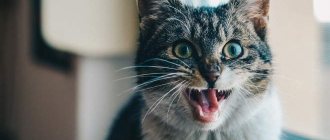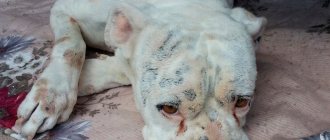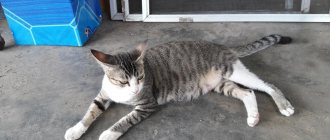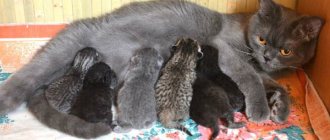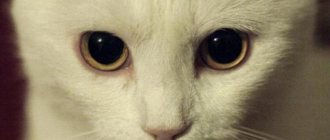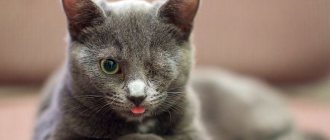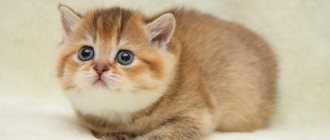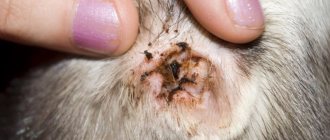There are diseases in cats that can frighten even the most experienced animal breeders and their owners. One of these diseases is convulsions in a cat that occur suddenly, and what to do, how not to get confused and panic at the sight of your pet convulsing, is what we will have to figure out in this article.
Convulsions in animals are very similar to an epileptic seizure in humans, and may even be accompanied by loss of consciousness. What are the causes of this condition in a cat?
Mechanism of seizures
Convulsive twitching of the paws or the whole body is always frightening.
Especially if you don’t know the nature of this phenomenon. This behavior is not typical for animals. Seizures are a dangerous pathology that is not an independent disease.
Muscle spasms are a sign that some organ or system of the animal has malfunctioned and affected the functioning of the brain.
How does this happen
By nature, cats have tissues and ligaments of the muscular system that are quite elastic. That’s why they manage to change so quickly from a relaxed state to an active one and vice versa. This transition is so smooth that it is difficult to notice from the outside.
But convulsions immediately catch the eye. At the same time, the cat not only twitches the body or individual areas - muscle cramps are accompanied by painful spasms.
Twitching can be single or repeated at regular intervals. But spasms always come suddenly and manifest themselves in different ways.
Types of seizures in cats
| Type | How it manifests itself |
| Convulsive | Mild twitching or muscle contractions are observed. The pet responds adequately to the owner |
| Tonic | Short-term, but repeated slow muscle contractions with a certain periodicity. The cat behaves restlessly, not just meows, but howls |
| Clonic | Contractions alternate with relaxation. The cyclicity is about 30-120 seconds. During convulsions, the pet falls on its side, and in the intervals between them makes attempts to move |
| Epileptic | The cat's muscles are constantly tense, he himself is in an unconscious state, often with his eyes open. If relaxation occurs, it lasts a few seconds. |
The last type of seizure is the most dangerous, as it usually ends in the death of the animal..
But even convulsive twitching does not go unnoticed for the pet. Therefore, it is important, with the help of a specialist, to determine the cause that provoked the seizures and try to eliminate it.
The main symptoms of a convulsive state
Often, signs of impending seizures in a cat can be noticed even before they begin. The animal becomes restless, does not find a place for itself, meows loudly, tries to stay close to the owner or, on the contrary, hides in a secluded place.
Convulsions are usually divided into clonic and tonic. The former are characterized by a rhythmic alternation of short-term sharp muscle contractions and relaxations. Such cramps are less painful, and in mild cases they look like muscle twitching. Tonic spasms are prolonged tension of a muscle group without a change in its strength.
When convulsions occur due to severe muscle spasms, the cat experiences pain, screams, its pupils are dilated, its limbs are tense in a bent or straightened state, or it makes chaotic movements. A large amount of saliva or foam may come out of the mouth. Uncontrolled urination or bowel movements are also possible. The cat does not react to its surroundings. Sometimes during convulsions the animal loses consciousness, although the respiratory function is usually not impaired.
A seizure usually lasts 3-5 minutes. When it ends, the animal may behave normally, or may look agitated and somewhat disoriented, or, on the contrary, experience slight weakness, lethargy, and a desire to sleep.
Causes of convulsions
All types of muscle contractions indicate that there are many factors that provoke symptoms.
To make it easier to make a diagnosis and carry out targeted treatment, the predetermining causes are divided into groups:
factors associated with brain dysfunction;- reasons that led to disruptions in the metabolic processes of the cat’s body;
- intoxication.
These are based groups that include entire lists of diseases in which sudden convulsions and seizures are possible.
Each cause of muscle contractions should be considered in detail so that you know what you have to face.
With brain damage
Pathologies affecting this organ are the most dangerous. Defeat can be caused by both external factors and internal processes.
Causes
| Disease | Peculiarities |
| Tick-borne encephalitis | When an ixoid tick bites, an infection enters the cat's body with the insect's saliva, causing the disease. Characteristic signs other than seizures:
|
| Hypoxia | Oxygen starvation can occur for a number of reasons, but in any case it leads to damage to brain tissue. At first, the symptoms are mild, and the seizures are so short-lived that the owner may simply not notice them. As the pathology develops, the number of convulsions and their duration increase. Hypoxia can be suspected by suddenly appearing shortness of breath, fainting, or cyanosis of the mucous membranes. |
| Rabies | Not just dangerous - a fatal disease caused by Babes Negri bodies. The animal's hind legs twitch first, then its limbs become paralyzed. While the cat is able to move, it shows strong aggression. The disease develops rapidly. Spasms pass from the body muscles to the respiratory muscles, and the animal dies from suffocation |
| Tumors | The initial stage of oncology has no obvious symptoms. They will appear when the tumor, growing, begins to put pressure on important areas of the brain. The animal's behavior changes: the cat becomes aggressive, loses orientation - constantly bumps into walls, objects, and monotonously circles in one place. The disease is often accompanied by convulsive seizures |
| Hydrocephalus | The cause is disruption of the outflow of fluid from the brain. The pathology is congenital and can be detected at an early stage. A kitten suffering from hydrocephalus has a larger skull volume than healthy babies, and it lags behind its brothers in development. The disease manifests itself as clonic convulsions, the first signs of which can be noticed at 2 months of age. The rapid development of pathology leads to death |
| Hematomas, injuries | Damage to the skull is accompanied by profuse vomiting. With severe injuries, loss of consciousness, paralysis of a group of muscles and twitching of those that hold the eyeballs are possible. |
Even an unbalanced diet, which provokes the development of vitamin deficiency, can cause brain damage.
In particular, this concerns vitamin B1 (thiamine), which is necessary for the smooth functioning of systems. The initial stage is manifested by trembling of the limbs; with severe deficiency, convulsions are observed.
How to give first aid
The main thing is not to panic. If a cat starts having convulsions, it looks scary; many furry owners fall into hysterics. Attacks happen suddenly, which means the first thing to do is remove sharp and potentially dangerous objects that the cat might touch.
© shutterstock
The next step is to take a blanket and wrap the cat up, but not too tightly. The warmth will make the cat feel better and this will protect the animal from unnecessary injuries. If you overdo it and squeeze the cramps, you can cause injury to your pet.
One solution could be massage, however, the effectiveness of this method is low . During cramps, the cramped limbs are massaged, and a heating pad is applied to the lower back. This will help reduce the amplitude of the spasm. But, as a rule, attacks in cats do not last long, so the owner simply does not have time to prepare anything.
The convulsions last about 2-3 minutes , after which the cat is in a comatose state for about 5 minutes. At this time, your pet needs care to avoid injuries and careless movements. In addition, affection will help calm a frightened pet.
If a cat has a seizure and severe convulsions begin, the use of drugs is strictly prohibited. On the Internet you can find recommendations about Valocordin and Corvalol. But for a pet, medication for treatment without a doctor’s prescription is a risk.
Calling a veterinarian is the best solution when your cat experiences spasms. But spasms and convulsions cannot be compared. Tremors can occur in cats after pregnancy or on the eve of childbirth, during “walking”. It is known that sterilized pets are less susceptible to such threats than non-neutered ones.
In adults, seizures are a clear indication of illness, which becomes natural and expected for an old cat. Older cats rarely die from injury or mutilation. In kittens, this may be a consequence of injury. Therefore, it is better not to delay in treating children. The kitten probably fell or hit itself while the owner was away, resulting in serious head damage.
Metabolic disorders
Failures in the functioning of internal systems disrupt metabolism and the rhythm of metabolic processes. This leads to an imbalance in the nervous system, and impulses are sent to the muscles “incorrectly,” which manifests itself in convulsions.
Metabolism-related diseases
| Name | Peculiarities |
| Eclampsia | It is observed during the period of gestation of kittens, at birth and feeding. A convulsive state develops against the background of a sharp decrease in the level of calcium in the blood and is accompanied by severe pain. In the initial stage, convulsive twitching is observed in the hind limbs. As the attacks progress, they become more frequent and affect the entire body. |
| Kidney failure | There are many factors that provoke this disease, from common infections to autoimmune pathologies. Failure of the kidneys interferes with the removal of toxins from the body. As a result, brain tissue is damaged. |
| Hypoglycemia | Blood glucose levels drop sharply. Convulsive attacks are accompanied by severe pain, causing the animal to writhe and scream loudly. This condition is similar to epileptic seizures |
| Intoxication | Toxic substances that enter a cat’s body have a negative effect on the nervous system. In mild cases, this provokes stool upset. In severe situations, intestinal bleeding is added to diarrhea. The cat is vomiting and writhing in convulsions |
Any disruption of metabolic processes if assistance is not provided in a timely manner will lead to the death of the pet.
Old age can also be included in this group of pathologies. In the body of old cats, degenerative processes occur that affect almost all organs, but the brain is the first to suffer.
Involuntary muscle twitching may be pre-death convulsions.
Convulsions or epileptic seizure?
We have already mentioned epilepsy several times. What is it and how can you distinguish epileptic seizures from “regular” seizures? Currently, many researchers propose to consider it not one disease, but a syndrome that combines different pathologies that can cause functional disorders of brain activity. Be that as it may, this disease is accompanied by strong and characteristic seizures, which nevertheless develop over several years (there are cases of rapid progression, but they are not so common).
When it comes to differentiation, things are complicated. It is believed that with a single seizure it is impossible to talk about epilepsy, but nevertheless seizures (a characteristic sign of both seizures and epilepsy) become more frequent over time, so they are not a reliable differential sign. Without a number of diagnostic studies (which we will discuss below), it is impossible to make an accurate diagnosis.
But! In everyday life, it is believed that an epileptic seizure cannot develop in a dream: such seizures are more typical during periods of wakefulness. Ordinary convulsions occur at any time.
Other reasons
There are other factors that do not fit into the structure of known groups. They are also dangerous and can cause death.
Postoperative period
Surgical interventions are accompanied by the administration of painkillers, anesthesia and other medications to the animal. If the operation was performed incorrectly or the dosage was incorrectly selected, the body may react to this with convulsions.
When prescribing medications, the doctor must take into account their individual intolerance.
Epilepsy
A systemic disease associated with changes in brain activity is always difficult, with severe, painful seizures and can result in the death of the pet at any time.
The pathology can be hereditary or develops against the background of trauma, inflammation of the membranes of the brain, or cancer.
Stress
Convulsive contractions are short-term in nature, accompanied by aggressive behavior and lack of appetite. This is due to strong stimulation of the nervous system after experiencing emotional shocks.
A cat can be stressed by bathing, moving, or the arrival of a new animal or small child in the house. In uncastrated pets, seizures may begin due to unsatisfied sexual instinct.
Diseases that cause cats to have seizures
Involuntary convulsions accompany many serious diseases:
- Epilepsy;
- Intoxication;
- Oncology;
- Brain injury;
- Diseases of the central nervous system;
Epilepsy is a disease with strong involuntary contraction of all muscle groups; over time, the condition becomes more serious and dangerous.
- Infection, the presence of inflammatory processes in the animal’s body;
- Sunstroke;
- Disturbances in the functioning of the endocrine system;
- Hypoxia of the brain structure;
- Deficiency of B vitamins;
What symptoms should you be wary of?
Any deviation in the animal’s usual behavior should be alarming.
To prevent seizures from becoming a surprise, you need to pay attention to the accompanying signs:
- uncontrolled urination;
- involuntary defecation;
- dilated pupils;
- flow of saliva or foam from the mouth.
It happens that an animal shows aggression, does not respond to the owner’s voice, and does not allow itself to be touched. This behavior is due to the fact that the cat is frightened by a sudden attack and severe pain.
Seizures and convulsions: what are they?
These concepts are not shared in veterinary medicine. They mean an uncontrolled convulsive contraction of one or more muscles, which is usually accompanied by a sharp, aching pain. There are 2 types of seizures:
- spasms of striated or skeletal muscles that impair motor ability;
- spasms of smooth muscles - the vascular wall, disrupting the functions of various organs.
First aid: owner actions
In such situations, a person’s self-control plays an important role. Timely measures taken will help save the life of a pet:
- During an attack, the cat must be carefully laid on a flat surface, which is covered with oilcloth or rags. At the same time, you cannot forcibly hold it, so as not to provoke unnecessary stress. You should not unclench your jaws, so as not to injure the animal.
During an attack, it is recommended to administer an anticonvulsant and analgesic to your pet. They do this by injection, and not by mouth: convulsions that seize the muscles of the larynx will not allow the cat to swallow the medicine, and it will simply choke.- A light massage will help ease the spasm. It is carried out on areas of the body affected by convulsions.
Even a small isolated attack is already a reason to urgently take your pet for examination. Convulsive muscle contractions don’t just happen. There needs to be a reason for this, and each of them is dangerous.
What actions should be taken during a seizure before the arrival of a specialist?
The main task of the pet owner is to notice the onset of a seizure in time. It will be nice if you can fix the animal on the floor
or some other flat surface.
Under no circumstances should you give medicine or water to your cat at this time, as this could cause death due to suffocation. If possible, it is necessary to massage the muscle
that has been cramped, it will shorten the duration of the attack and
apply a heating pad
, with its help the body will relax and warm up.
Information that must be provided to a veterinary emergency specialist if a seizure occurs
It will be of great help for your pet if you provide information to a specialist at the veterinary emergency center about how the attack occurred, about the diseases the animal suffered from, about its lifestyle and dietary preferences. This way, you can help quickly determine the cause of your pet’s convulsive condition, after which treatment will be prescribed. You should also provide information such as:
- how old or months old is the pet, when exactly were the first seizures noticed;
- what type of seizures are they: regular, rapid or prolonged;
- during what period the attacks are observed: during meals, when the animal awakens or when sleeping;
- whether the animal eats raw foods such as fish or meat;
- what illness did the cat have and what medicine did she take;
- whether the animal suffered stress.
Treatment: basic measures
Therapy for convulsive states is necessary in any case, but it is prescribed only after examining the animal. Therefore, all treatment is divided into stages.
Step one - diagnosis
The doctor asks the owner how the attacks manifested themselves and what they were accompanied by. When compiling an anamnesis, it is important to know what the cat ate the day before, how it behaved, and whether there were stressful situations or injuries.
Blood and urine tests are taken from the animal. The cat is sent for hardware examination (ultrasound, MRI). Only after collecting all the results does the doctor move on to the next stage.
Step two - choosing treatment tactics
In each specific case, an individual course of therapy is selected. First of all, it is necessary to act on the factor that provoked the cat’s seizures. Often an epileptic attack is stopped with Promidon.
Symptomatic treatment includes the following:
- prescription of analgesics;
- antiemetics;
- solutions that prevent dehydration;
- vitamin complex.
You can quickly eliminate cramps with Pagliferal or Phenobarbital.
But these injections are done only in a clinic under the supervision of a doctor, since the drugs are toxic and an overdose cannot be allowed.
How to treat seizures in a cat
Anamnesis is of decisive importance in diagnosing the disease. Blood is taken from the cat for biochemical analysis. A chest X-ray and an abdominal ultrasound are performed. If it is determined that seizures are signs of an underlying disease, appropriate treatment is given.
Be sure to read:
The cat is drooling from the mouth: physiological and pathological causes, when to treat
Once idiopathic epilepsy is diagnosed, there is no chance of recovery. However, with lifelong treatment with antiepileptic drugs and proper care, the cat can live a long time in satisfactory health.
Anticonvulsants are prescribed individually and used in accordance with the treatment regimen. Skipping medication may result in seizures. I consider treatment successful if the seizures stop or the intervals between them are at least doubled. The owner of the animal will have to keep an observation diary, recording everything that happens to the pet.
Preventive measures
Prevention will help you avoid problems related to your pet’s health:
- diet with the selection of balanced feeds;
immunization and deworming of the animal;- regular treatment against parasites;
- timely treatment of infectious diseases.
Preventive visits to the veterinarian 1-2 times a year will help to promptly identify and eliminate diseases of internal organs and systems.
